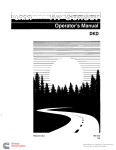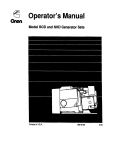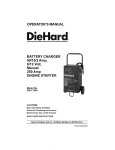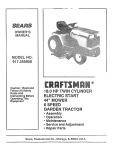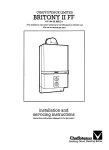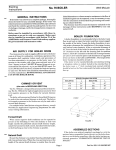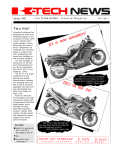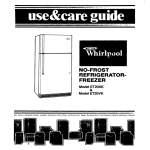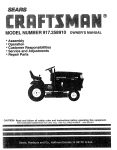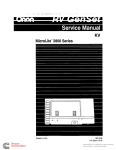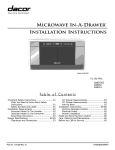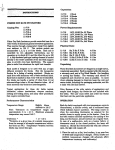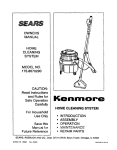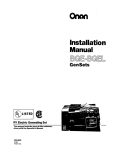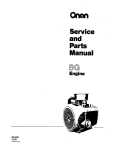Download 981-0627 Onan KY Microlite 4000 series Installation manual
Transcript
KY MicroLiteTM 4000 Series Printed U.S.A. 2-93 981-0627 Redistribution or publication of this document, by any means, is strictly prohibited. Table of Contents . SECTION TITLE PAGE SAFETY PRECAUTIONS...................................... ii.iii 2 INTRODUCTION ............................................ General .................................................. Installation Codes and Safety Recommendations ................. Component Locations ....................................... SPECIFICATIONS ........................................... 1-1 1-1 1-1 1-2 2-1 3 STEP-BY-STEP INSTALLATIONOUTLINE ....................... Introduction ............................................... Preparation ............................................... 3-1 Compartment Mounting ...................................... Under-Floor Mounting ....................................... Connecting to Vehicle Systems ............................... Exhaust System ........................................... MOUNTING ................................................ General .................................................. compartment Mount ........................................ Under-Floor Mount ......................................... VENTILATION AND ACOUSTICS ............................... 3-1 3-1 3-2 3-3 3-5 3-6 4-1 4-1 4-1 4-4 5-1 Ventilation ................................................ Acoustics ................................................. EXHAUST SYSTEM .......................................... 5-1 5-2 6-1 6-1 6-1 6-1 6-1 7 General .................................................. Muffler Recommendations ................................... Exhaust Installation Guidelines ................................ Tailpipe Recommendations ................................... FUEL SYSTEM .............................................. 8 General .................................................. Gasoline Fuel System ....................................... LPG Fuel System .......................................... ELECTRICALCONNECTIONS ................................. 7-1 7-1 7-3 8-1 General ................................................... AC Wring DCWiring INITIAL START AND CHECKS Pre-Start Checks ........................................... Initial Starting and Checks ................................... Installation Review 8-1 8-1 8-5 9-1 9-1 9-2 9-4 10-1 1 4 9 10 ................................................ ................................................ ................................. ......................................... WIRING SCHEMATIC/DIAGRAMS ............................. 7-1 Redistribution or publication of this document, by any means, is strictly prohibited. i Safety Precautions Before operating the generator set, read the Operator's Manual and become familiar with it and the equipment. Safe and efficient operation can be achieved only If the unit is properly operated and maintained. Many accidents are caused by failure to follow fundamental rules and precautions. GASOLINE AND LPG FUEL MAY BE ACCIDENTALLY IGNITED BY ELECTRICAL SPARKS, presenting the hazard of fire or exploslon that can result in severe personal injury * 4 or death. When lnstalllng the generator set: Keep electrical and fuel lines as far apart as possible. Do not allow contact unless both lines are sheathed. The following symbols, found throughout this manual, alert you to potentially dangerous conditionsto C~ or the equipment. the operator, S ~ M 'personnel, EXHAUST GASES ARE DEADLY This symbol warns of immediate hazards which will result in severe personal lnjuv or death. Never sleep in the vehicle with the generator set running unless the vehicle is equipped with an operating carbon monoxide detector. Provide an adequate exhaust system to properly expel discharged gases. Do not use engine cooling air to heat a compartment. /-(This symbol refers to a hazard or unsafe pmctice which can result in severe personal injury or death. Be sure the unit is well ventilated. [-This symbol refers to a hazard or unsafe practice which can result In personal injury or product or properiy damage. MOVING PARTS CAN CAUSE SEVERE PERSONAL INJURY OR DEATH Before starting work on the generator set, disconnect batteries. This will prevent accidental starting and electrical arcs. Disconnect the Negative (-) battery cable first to reduce the risk of arcing. FUEL AND FUMES ARE FLAMMABLE Fire, explosion, and personal injury can result from improper practices. Keep your hands away from moving parts, Do not smoke or allow an open flame or sparkproducing equipment near the generator set or fuel tank. Make sure that fasteners on the generator set are secure. Tighten supports and clamps, keep guards in position over fans, drive belts, etc. Fuel lines must be adequately secured and free of leaks. Fuelconnection at the engine should be made with an approved flexible, nonconductive line. Do not wear loose clothing or jewelry while working on generator sets. Loose clothing and jewelry can become caught in moving parts. Jewelry can short out electrical contacts and cause shock or burning. If adjustment must be made while the unit is running, use extreme caution around hot manifolds, moving parts, etc. Redistribution or publication of this document, by any means, is strictly prohibited. ii 9 4 ELECTRICAL SHOCK CAN CAUSE SEVERE PERSONAL INJURY OR DEATH GENERAL SAFETY PRECAUTIONS Wear safety glasses and protective clothing when servicingbatteries. DO NOTSMOKEwhile servicing batteries. Lead-acid batteries emit a highlyexplosivehydrogengas that can be ignited by electrical arcing or by smoking. Disconnect the negative (-) cable at the starting battery before removing protective shields or touching electrical equipment. Use rubber insulative mats placed on dry wood platforms on the ground or over floors that are metal or concrete when around electrical equipment. Do not wear damp clothing (particularty wet shoes) or allow skin surfacesto be damp when handling electrical equipment. 0 0 0 Have a fire extinguisher rated ABC nearby. Maintain extinguisher properly and become familiar with its use. 0 Use extreme caution when working on electrical components. High voltages can cause injury or death. Follow all state and local electrical codes. Have all electricalinstallationsperformedby a qualified electrician. Tag open switchesto avoid accidental closure. 0 DO NOT CONNECT GENERATOR SET DIRECTLY TO ANY BUILDING ELECTRICAL SYSTEM. Hazardousvoltages can flow from the generator set into the utility line. This creates a potential for electrocution or property damage. Connect only through an approved device and after building main switch is open. Consult an electrician in regard to emergency power use. Benzene and lead, found in some gasoline, have been identified by some state and federal agencies as causing cancer or reproductive toxicity. When checking, draining or adding gasoline, take care not to ingest, breathe the fumes, or contact gasoline. Used engine oils have been identified by some state or federal agencies as causing cancer or reproductive toxicity. When checking or changing engine oil, take care not to ingest, breathe the fumes, or contact used oil. Do not wok on this equipment when mentally or physically fatigued, or after consuming any alcohol or drug that makes the operation of equipment unsafe. RGA-IN1 Redistribution or publication of this document, by any means, is strictly prohibited. iii Redistribution or publication of this document, by any means, is strictly prohibited. 1 Introduction INSTALLATION CODES AND SAFETY RECOMMENDATIONS GENERAL This manual provides installationguidelines for the MicroLitem (KY) generator set. The generator set The following list of Installation Codes and Safety Recommendations applies to the installation and operation of RV generator sets. The address of each agency is listed so that copies of the codes may be obtained for reference. Installation codes and recommendationsare subject to change, and may vary by location or over time. The RV manufacturer and the genset installer bear sole responsibilityfor following all applicable codes and regulations. must be installed properly to operate reliably, quietly, and safely. Read this entire manual before starting the installation. For operation and maintenance procedures, see the Operator’s Manual (981-0132) that accompanies each genset. When properly installed, this generator set meets or exceeds the following requirements: NationalElectrical Code, NFPA 70-Article551 ANSVRVIA EGS-1 - 1986, Generator Set Standard ANSI A I 19.2/NFPA 501 C Standard for Recreational Vehicles 1. ANSI-A119.2 FMVSS 301 Recreational Vehicle Industry Association 14650 Lee Road Chantilly VA 22021 2. NFPA 70 (N.E.C.) National Fire Protection Association 470 Atlantic Avenue Boston MA 02210 NFPA-501C NFPA 58 NFPA Liquefied Petroleum Gas CSA Electrical bulletin 946 The RV manufacturer and/or the set installer must comply with localcodes such as Californiaadministrative Code title 25, which applies to generator set installation. The RV installer bears sole responsibility for the selection of the appropriate generator set, installation design, and installation. Consider the following requirementsbefore installing the set. Each topic is covered in the following text. 3. CSA Electrical Bulletin #946 Canadian Standards Association, Housing and Construction Materials Section 178 Rexdale Blvd. Rexdale, Ontario, Canada M9W 1R3 4. California State of California Documents Section P.O. Box 1015 North Highlands, CA Administrative Code - Title 25 Chapter 3 95660 Level and supportive mounting surface Adequate cooling air This manual contains informationthat is subject to change. For this reason, use only the installation manual supplied with the generator set for the installation. Adequate fresh induction air Discharge of circulated air Noise levels Incorrect installation, service, or replacement of park can result in severe personal injury, death and/or equipment damage. Sewice personnel must be qualified to perform electrical and/or mechanical component installation. Redistribution or publication of this document, Accessibility for maintenanceand service Exhaust connections Fuel supply Electrical connections MicroLite is a trademark of the Onan Corporation by any means, is strictly prohibited. 1-1 COMPONENT LOCATIONS so the arrows point to the right. Pull the top of the cover away from the housing. The standard control panel and routine maintenance items are located behind the access cover (Figure 1-1). To secure the access cover; Positionthe bottom of the cover over the base. Push the top of the cover in and turn fasteners onequarter turn counterclockwise so the arrows point up. . To remove the access cover: Rotate the fasteners on the access cover onequarter turn clockwise ' 1-1 Operation of the generator set with the access cover removed can result in severepersonal injury or equipment damage. Hot components are exposed when theaccess cover is removed and generator set cooling air does not circulateproperly. Do not operate the generator set with the access cover removed. i MUQNSIDE COVER) - SPARK PLUG ACCESS DRAIN ON BOlTOM (NOT SHOWN) \ AC CONDUIT CONNECTlON CARBURETOR ALTITUDE CIRCUIT NEGATIVE (-) CONNECllON sTART/sTOP SWrrcH BREAKER QUARER-TURN FASTENERS P- ACCESS COVER Redistribution or publication of this document, by any means, is strictly prohibited. AGURE 1-1. MICROLITE (KY) GENERATOR SET COMPONENT LOCATIONS 1-2 L 2. Specifications . ~ MODEL 4000 KY 3600 KY (LP) Onan? Revolving Field, 2-Pole 60 4000 120 33.3 Onan , Revolving Field, 2-Pole 60 3600 120 30 Onan E095H-G 4-StrokeYSingle Cylinder, OHV 3600 rpm Electronic Magneto (Breakerless) Gasoline 1.7 qt (1.6 L) Onan E095H-G 4-Stroke, Single Cylinder, OHV 3600 rpm Electronic Magneto (Breakerless) LPG Vapor (11 inches W.C.) 1.7 qt (1.6 L) 12-Volt 360 (450 Below 32OF [OOC]) 0.025 in. (0.64 mm) 12-Volt 360 (450 Below 32OF [ O O C ] ) 0.025 in. (0.64 mm) 0.15 gph (0.57 Uh) 0.40 gph (1.51 Uh) 0.66 gph (2.5 Uh) 0.35 gph (0.54 Uh) 0.54 gph (2 Uh) 0.82 gph (3.1 Uh) 30 in. (762 mm) 19.4 in. (493 mm) 13.8 in. (350.2 mm) 168 Ib (76.2 kg) 30 in. (762 mm) 19.4 in. (493 mm) 13.8 in. (350.2 mm) 168 Ib (76.2 kg) 19 ftVrnin (0.54 m3/min) 300 ftWnin (8.5 m3/min) 3 ft (0.91 m] 19 ftVmin (0.54 m3/min) 300 ftVmin (8.5@/inin) GENERATOR Generator Type Frequency (Hertz) Power (Watts) Voltage Current (Amperes) ENGINE Engine Model Engine Type Engine Speed Ignition Type Fuel Engine Oil Capacity Battery Requirements: Battery Size Cold Cranking Amps Spark Plug Gap Average Fuel Consumphn: No Load Half Load Full Load GENERATOR SET DETAILS Dimensions: Length Width Height Weight Air Requirements: Combustion Engine/Generator Cooling Fuel Pump Lift - Redistribution or publication of this document, by any means, is strictly prohibited. Redistribution or publication of this document, by any means, is strictly prohibited. 3. SteD-Bv-SteD Installation Outline INTRODUCTION This section is a step-by-step overview of a typical installation. This section includes: Preparation 0 Compartment Mounting 0 Under-Floor Mounting Connecting to Vehicle Systems 0 Exhaust System Review this section, then refer to the detailed instructionsthat are given in sections four through eight for specific procedures and important safety precautions before starting the installation. The installer is responsible for complying with all applicable installation codes and safety requirements. 0 PREPARATION 1. Remove the wooden shipping crate by prying the bottom of the crate's sides and ends out from the wooden skid base. Carefully lift the crate off the genset and discard. Remove the plastic bag covering the genset and collect loose shipped items, like the Operator's Manual, and add them to the vehicle documentation package. FIGURE 3-1. CRATE REMOVAL 2. Remove the mounting bolts that secure the wooden skid to the ends of the genset base. GENSET SHIPPING 4 I FIGURE 3-2. Redistribution SKID BASEorREMOVAL publication of this document, by any means, is strictly prohibited. 3-1 COMPARTMENT MOUNTING Installthe generator set in its own compartment. If any part of the compartment is above the vehicle floor, separate the compartment from the living quarterswith vapor-tightwalls. Referto the Mountingsection for compartment construction details. Vehicles that are unusually sensitive to vlbration may require secondary Isolatlon and a larger compartment. lgWAR"GJExhaust gases present the hazard of severe personal Injury or death. Make the compatfment walls vapor tlght to the inferior of the vehicle to prevent exhaust fumes from enferlng fhe llvlng quarters. The generator set requiresanunobstructedair inlet of at least 40 square inches (258cm2). Refertothe Mountingand Ventilation section for details. Provide an adequate genset access for maintenance (11.25 X 19.5 inch minimum opening) and service removal either through the door or out the bottom. 1. Carefully measure the compartment size to make sure there will be proper clearance for the generator set. Figure 3-3 shows the compartment dimensions. Add 1/2 inch to compartment depth if 1/2-inch insulation is used inside the door. Allowing one to two inches of added space on the left side of the compartment will make electrical and fuel connections easier. ~ I NFPA70 225wh-II I @Ea 551-30 (d) dn MINIMUM COMPARTMENT DIMENSIONS FIGURE3-3. COMPARTMENT DlMENSlONS 2. Put holes in the bottomof the compartmentfor genset mounting, air outlet and oil drain (Figure 3-4). If the bottomof the compartment is wooden, remove the wooden section under compartmentand replace it with a sheet metal floor and an adequate steel support frame. (Refer to Onan template number 539-1383). DMNAGE HOLES \ OIL DRAIN I GENSET MOUNTING / HOLES AIR OUTLET USE TEMPLATE OR SEE FIGURE4-2 uiw6 Redistribution or publication this document, FIGURE 34. COMPARTMENT FLOORofTEMPLATE by any means, is strictly prohibited. 3-2 3. Put holes in the compartment to run connections for the fuel line, battery cable, remote control harness and AC conduit. Design holes so they will not chafe or restrict the lines. LOCATE FUEL AND ELECTRICAL LINE ENTRANCE HOLES IN SHADED AREA If the remote control harnessor AC conduit go directly into the interior of the vehicle, seal around the wires and inside the conduit to prevent the passage of exhaust gases. The fuel line must not be routedthrough the interior of the vehicle. UlmM I FIGURE 3-5. GENSET TO VEHICLE SYSTEMS CONNECTIONS 4. Mount the generator set in the compartment with four 5/16-16 screws. Screw length must not protrude more than I/Z-inch (13 mm) through the genset base. The exposed above floor section of exhaust pipe must be shielded with the Onan-supplied exhaust shield. 5. Proceed to Connecting To Vehicle Systems (page 3-5). I12 INCH luAx PROTRUSION 5/16-16 SCREW UNDER-FLOOR MOUNTING 1 I SUPPORT THICKNESS flGURE 3-6. COMPARTMENT MOUNTING An optional kit is requiredfor under-floormounting. Support brackets are used to suspend the genset below the floor of the vehicle. Refer to the instructionsthat are supplied with the kit for specific installation instructions and important safety precautions. For additional under-floor mounting information refer to the Mounting section. 1. Use the template to locate the holes in the vehicle support structure. (Reference Onan template number 539-1382). 1- Fallure to provlde an adequate support structure can resuIt In severe personal Injuv, death, and/or q u I p e n t damage. Carefully follow the Under-FIoor HousIng kif Installation instrvctions and provlde an adequate support structure. Use spcifled hardware and tighten all mounting hardware to the recommended torque seftlngs. 0.406IN. HOLES (4) FOR 3/8 BOLTS Ml88E FIGURE 3-7. UNDER-FLOOR MOUNTING TEMPLATE Redistribution or publication of this document, by any means, is strictly prohibited. 3-3 2. If the areaabove the compartment is made of a wood product, you must install a 26gauge (0.02-inch) galvanized metal plate (or equivalent) above the genset. NFPA 70 (NEC)551-30 (9 ,id@ rLI, -- e AREA ABOVE SET, APPROX 20 INCH X 30 INCH, MUST BE METAL YlIM-1 FIGURE 3-8. UNDER-FLOOR MOUNTING KIT WITH METAL CEILING (NOT SUPPLIED WITH KIT) 3. Assemble the Under-Floor Housing kit according to the instructions supplied with the kit. Securely mount hanger brackets and side panels to the under-floor support structure. 1- Dropping ihegeneratorset can cause severe personal injury or death. Make sure no onemoves the vehicle during insWatlon and keep feet and hands clear durlng Insfallaiion. FIGURE 3-9. UNDER-FLOOR MOUNTING KIT 4. Assemble the front and back rails to the genset. U s e z forklift to carefully raise the genset into position in the support frame. Secure the rails to the support frame with the mounting hardware included in the Under-Floor Housing kit. , 5. Proceed to the next section on connecting to the vehicle systems. FIGURE 3-10. UNDER-FLOOR Redistribution or publication of this document, INSTALLATION by any means, is strictly prohibited. 3-4 CONNECTING TO VEHICLE SYSTEMS 1. Route fuel line separate from electricalwires or separate them with conduit or other sheathing. BAlTERY POSITIVE (+) CABLE /aWAR”GI Fuel presents thehazard of fire or explosion that can result in severe personal injury or death. Do not smoke or allow any flame, spark, pllot light, arc-producingequipment or other ignition sources near fuel or in the installatlonarea. Read the important safefy precautions in the Fuel Systems section. .I I FUEL LINE u1m I FIGURE 3-11. FUEL AND ELECTRIC LINES 2. Gasoline Fuel: Connect 1/4-inch I.D. fuel hose (typeSAE 30-R7)to the barb fitting on the generator set. LPG Fuel: Connect 3/8-inch I.D. fuel hose (see LPG Fuel Sysfem) to the barb fitting on the generator set. Secure fuel hose to barb fitting with a stainless steel clamp (worm-gear type). Do not over tighten clamp or hose could be damaged. FIGURE 3-12. FUEL LINE CONNECTION 3. Installa listed 1/2-inchflexible conduitover the NFPA 70 (NEC) 551-30 (e) AC wiring. (Use water-tight conduit for underfloor mounting.) Secure the conduit to the fitting on the generator set. , Accidental starting can cause severe personal injury or death. Do not connect the battery cables to the genset startlng battery until instnrcted to in the Initial Start and Checks section. FIGURE 3-13. AC CONDUIT CONNECTION 4. Remove the service access cover. Route the battery positive (+) cable through the access hole inthe left side ofthe housing. Connectthe battery positive (+) cable to the B+ connection on the start solenoid. START SOLENOID publication(+) of this document, FIGURE 3-14. Redistribution BATTERY or POSITIVE by any means, is strictly prohibited. CONNECTION 3-5 5. Connect the battery negative (-) cable (with a W8-inch ring terminal) to the ground connection on the left side of the base. Refer to the Electrical Connections section for important genset grounding instructions. LQWAR”GjFai1ure to ground the genset properly can result in Injwy or death. If the genset is not grounded to the vehiclechassis thtvugh the baitery negative (-) cable, atfach an 8 AWG equipment ground wlre between the vehicle chassis and the battery negative (-) connection. FIGURE 3-15. BAlTERY NEGATIVE (-) CONNECTION 6. Route the remote control connector through the access opening in the left side of the housing. Connect the remote control connector to the mating connector inside the genset. TO REMOTE 7. Proceed to the next section on connecting the exhaust system. REMOTE CONTROL CONNECTION EXHAUST SYSTEMS FIGURE 3-16. REMOTE CONTROL CONNECTION lCgWAR”G1Ekhaust gas presents the hazard of severe personal injury or death. Do not temrlnafe the exhaust pipe under the vehicle. The exhaust pipe must not tennlnate so #?at any vent) window, or opening Into the llving area is wlthln the triangular area shown in figure 3-21. Read the important safety precautions In the Exhaust Systems section. 1. Connect the exhaust pipe (1 1/2-inch O.D. or 13/8-inch I.D., installer-supplied) to the genset with a U-bolt clamp. A short-radius exhaust elbow is supplied with the generator set for installations that require a tight turn of the exhaust pipe at the outlet. Use the Onan-supplied exhaust shield for compartment mount installations whenever the exhaust elbow is turned down for through-thefloor installations. UBOLT / EXHAUST PIPE I EXHAUST SHIELD ~ or publication of this document, FIGURE 3-17.Redistribution EXHAUST PIPE CONNECTION by any means, is strictly prohibited. 316 2. Do not terminate the exhaust tail pipe under the vehicle. The exhaust tail pipe must ANSI 119 2 PAR. 3-4.3 terminate 1 inch (25.4 mm) beyond the side or end of the vehicle. MTEND TAlL PIPE In PAST OUTSIDE EDGE OF VEHICLE OUTSIDE EDGE OF VEHICLE d -elk 1" miin FIGURE 3-18. TAIL PIPE EXTENSION BEYOND VEHICLE 3. Support the tail pipe as close to the outside of the vehicle as possible. ~ 1 LOCATE TAIL PIPE HANGERCLOSE OUSIDE EDGE OF VEHICLE TAIL PIPE HANGER FIGURE 3-19. EXHAUST PIPE SUPPORT 4. Termination of the exhaust tail pipe below the angle of departure (lowest point on rear of vehicle to the tire ground contact point) must be protected by a skid bar, trailer hitch, or some frame member. L ANSI 119.2 PAR. 3-4.3 LOCATETAlL PIPE IN SHADED .. AREAORABOVE I KID BAR I US186 FIGURE 3-20. TAIL PIPE PROTECTION 5. Be aware that any vent, window, or opening that can be opened and that is not permanently sealed from the vehicle living space, can be an avenue for carbon monoxide. The tail pipe must not terminate so that any vent, window, or opening into the living area is within the triangular area shown in Figure3-21. ANSI 119.2 PAR 3-4.3 NO OPENINGS INTO VEHICLE'S INTERIOR, INCLUDING ENTRY WORS, ARE ALLOWED IN THIS AREA 6. Refer to each of the sections in this manual for detailed installationinstructionsand for important safety precautions. Always follow the procedures in the Initial Start and Checks section when the installation is complete. FIGURE 3-21.Redistribution TAIL PIPE or LOCATION publication of this document, by any means, is strictly prohibited. 3-7 Redistribution or publication of this document, by any means, is strictly prohibited. 4. Mounting If insulation is used to line the compartment, increase the compartment size to include the width of the insulation. 2. If any part of the compartment is above the vehicle floor, separate the compartment area from the living quarters and fuel supply with vapor-tight walls. 3. Line the compartment walls with 26gauge galvanized steel or a material of comparable strength and fire resistance (see NFPA 70, NEC and California Title 25 for complete detaiIs). GENERAL MicroLite generator sets are designed for either compartment or underfloor mounting. Choose the appropriate part of this section and carefully follow the instructions. Read any applicable kit instructions before installingthe generator set. COMPARTMENT MOUNT In a compartment mount, the genset is installed in a frame that is part of the vehicle. This frame must be constructed according to safety-approved specifications (see Compartment Construction in this section). Vehlcles that are unusually sensitive to vlbration may requlre secondary isolation and a larger laWAR"GIExhaust gases present the hazard of severe personal injury or death. Make the comparfmenfwaiis vapor-tightto the Interior of the vehicle to prevenf exhaust fumes fmm entering. 4. Construct a compartment floor that will prevent compartment. Unlessthe set will be removedfrom underneaththe vehicle, make the access opening large enough to remove the set. Allow enough clearance for removal of the access cover. See Figure 1-1. oil, fuel or water accumulation. Provide openings in the compartment floor according to the Compartment Floor Plan, Figure 4-2. Do not use absorbent soundproofing material on the comparlment floor or oil and gas could cause a fire hazard. The floor should have as few openings as possible, to reduce the noise level. Minimum compartment dimensions are shown in Figure 4-1. Clearancesbetweenthe genset and the compartment are included in these dimensions. Allow for air intakeat the front left side of the set and air discharge at the bottom of the set. Air inlets to the set compartment must not allow dirt, rocks, water, or slush to reachthe set. Minimize dust and salt entrance into the compartment. (See Venfilafion section.) 5. Equip the base with an oil drain hole to the outside of the compartment. Do not mount the exhaust pipe below the oil drain hole. 1- Exposed above-floor section of exhaust pipe must be shieldedwith the Onan-suppliedexhaust shield. Compartment Constructlon Fire presents the hazard of severe personal injury or death. Do not positlon the exhaustplpe directlybelow a draln hole. Hot exhaust can ignite fuel or 011. 6. Secure the genset mounting base to the support frame with four 5/16-18 UNC grade 5 screws. The mounting bolts must not extend morethan 112inch (3 Imm)intothe base. See Figures 4-1 and 4-2. Torque 5/16 inch mounting screws to 15 ft Ibs (20 Nam). 1. Install the gen set in its own compartment. Allow a minimum of W i n c h (6.4 mm) clearance at the front, sides, back and top of the set. See Figures 4-1 and 4-2. Allow additional front (service side) clearance if the vehicle air inlet is not aligned with the genset air inlet, to obtain the minimum free air inlet of 40in2(258 cm2). Example: If the air inlet is alongthe entire bottom front edge of the compartment, increase the front clearance to 1-113 inches (34mm). 40 in2 i 3 0 in (air inlet length) = 1-1/3in. 1- If the mounting base is not fas- tened securely to the vehlclecomparfmenf, road vlbration wiil damage thegenset components. Use iong enough screws for at ieast 1-1/2 threads to extend through the weld nut. The mountingbolts must not exor publication of this document, 7/2 in. (13mm) intoisthe base. tend more thanRedistribution by any means, strictly prohibited. 4-1 12-9 --. -I M) 3.8.2 IN I ~ I - . .- - _.. - NOTES I Top GENW pwjINEpD SERVICE SIDE BACKSIDE HIN FREE AIR uffpkI#.rr 0. 6.4 6.4 6.4 6.4 6.4 258& .25 IN IN .=IN .25 .25 IN .25 IN &IN. 76.2KG168LB 4. MHAusf PIPE SHIELD Musf BE USED Fa?COCPARTMHT INSTALLATIONS. FOR MDERROOR INSTALLATIONS IT MAY BE RMOVED. ~- 5. HINIPUH INSTAuAfIoN SIZE IS URGERANDVARIESWITH MOUJTWG KIT USED Redistribution or publication of this document, FIGURE 4-1. COMPARTMENT OUTLINE DRAWING by any means, is strictly prohibited. 4-2 712 t- 28.0 IN -7 I 11.6 IN 4x1 Mou 13 PRO am 2nd - -39.a 1.57 OIL # U I N 64' 17 IN IN -292.1 11.5 i24m 4.9r f I 3 214.2 8.4, IN IN t -28.8 1.14 IN t 27.3 1.07 -I IN 1 38.3 1.50 PI -AIR I N A S L: 649.7 25.6lN I IL m 13 iP( #zApuGE DRAWING NOTES ON PAGE 4-2 FIGURE 4-2. COMPARTMENT FLOOR PLAN Redistribution or publication of this document, by any means, is strictly prohibited. 4-3 Under-floor mounted sets do not require the exhaust pipe heat shield. UNDER-FLOOR MOUNT In an under-floor installation, the generator set is mountedbelow the floor and outsidethe passenger compartment of the vehicle. This type of installation must comply with the Installation Codes and Safety Recommendations (see Introduction section). Read this section for general application information, and study the under-floor housing kit instructions for more information on under-floor installations and important safety precautions. laWAR"G]Fire presents the hazard of severe personal injury or deafh. Install a metal barrier between the generator set and any wooden or flammableparts of the vehicle. Generator Set Location Figure 4-3 shows the most common mounting areas for a generator set. Protectthe generator set from road splash and debris. If possible, drive the vehicle through mud and slush to test the installation. The vehicle stmcture must be able to support the weight of the generator set (see Specifications section). The vehicle manufacturer and/or the installer must provide a structurally sound support frame, using tubing, angle brackets, or steelreinforced plywood or other composition board. Plywood or particle board can be reinforced with 3-inch (76 mm) or larger washers or a full metal plate. Leave a minimum space of 1-112 inches (38.1 mm) between the generator set and the vehicle skirt for an air inlet if a side air inlet is not aligned with the genset air inlet. Provide a minimum back, top, and side clearance of 0.25 inches (6.4 mm). The air inlet opening to the generator set compartment must not admit dirt, rocks, water or slush. The entrance of dust and salt into the compartment must be minimized. Baffles may be needed to protectcertain areas. See the Ventilationsection of this manual for more detailed information. Ifthe generator set will be installedbelow a wooden floor, a metal barrier must be installed between the wooden floor and the generator set. Use 26-gauge (0.021 7 inch) painted or galvanized sheet metal or a material of comparable strength and fire resistance (see NFPA 70, NEC and California Title 25 for complete details). Redistribution or publication of this document, FIGURE 4-3. COMMON GENERATOR SET MOUNTING AREAS by any means, is strictly prohibited. 4-4 MountingBrackets: The vehicle must be adapted for use with the under-floor mounting bracket kit. The construction of the vehicle must support the weight of the generator set (see s~~ificafions section). it is the vehicle manUfaCtUrer and/or the installer's responsibility t0 provide hardware t0 attach the mounting brackets. Access Openjng; Provide an access opening to the generator set on the side of the vehicle. Make the access large enough to allow for removal of the generator set access cover. AISO allow access to the oil drain located at the bottom of the set, SO the generator set does not have to be removed for servicing (see Figure 1-1for service locations). Review the €xhaust System section. Plan clearances for moving or removingexhaust components when the set is removed for service. Redistribution or publication of this document, by any means, is strictly prohibited. 4-5 Redistribution or publication of this document, by any means, is strictly prohibited. 5. Ventilation and Acoustics VENTILATION 1- Operating thegenerator set wjth the cover removed can cause equipment damage. Generator set cooling air does not circulate properIy with the access cower removed. Do not operate the generator set with the access cover removed. The most important factors of ventilation for an air cooled generator set are sufficient incoming air (for combustionand cooling) and adequate exhausting of heated air. When designing the air inlet and outlet for the set compartment (see Figures 4-1 and 4-2), allow for the restriction of grilles and ductwork: some expanded metal grilles provide only 60 percent free-air inlet area per square foot. The most efficient grille provides only 90 percent free inlet area per square foot. Obtain the free inlet area of the grille material from the material supplier. Multiply the grille area by the free area percentage to get the free inlet area. The minimum size of the free air inlet is 40 in2 (258 cm2). The compartment size, air inlet opening size and grille design must meet the minimum air inlet opening requirements. A fan draws cooling air through the inlet on the generator end and pushes it across the generator and engine cooling fins. The heated air is expelled through the air outlet on the bottom of the set See Figure 5-1. Make certain that nothing obstructs or restricts the air intake and air outlet. Air recirculation must be minimized. If a noise or dust deflector are addedto the set, it must be located a minimum of 6 inches (150 mm) below the generator set and it must be open on three sides. 1- Exhaust gas presents the hazard of severe personal injury or death. Because discharged coolingair can contain deadly exhaust gas, never use discharged cooling air to heat the vehicle. Air ducting must provideadirect free-airflow pathto the generator set, with minimal bends. The duct must be smooth and non-restrictiveto airflow. Air inlet openings should be located as high as possible to allow for convection cooling of heated air from the generator set Compartment after unit shutdown. Otherwise, hard starting could result from vapor locking, hot combustion air, etc. 1- Fuel and fuel leakage present the hazanl of fire or explosion, which can cause severepersonal injury or death. Theventiiation system should provide a constant flow of air to expel any accumu!ation of fuel vapor. The generator set compartmentmust be vapor-tight to the vehicle inferior, to keep fumes from entering the vehicie. Locatingthe free air inlet openingin thevehicle skirt or side access door is recommended. If the vehicle skirt does not extend to or below the bottom of the generator set, provide an extension. Inlet air taken from below the vehicle must come from the skirt side of the compartment. FIGURE 5-1. COOLING AIRFLOW Redistribution or publication of this document, by any means, is strictly prohibited. 5-1 ACOUSTICS 0 The genset is designedto minimize noise levels. If additional noise reduction is required, line the top and sides of the genset compartmentwith a 1 inch (25.4 mm) thickness of sound absorbing material. The optionalexhaust resonator can also be usedto lower the noise level. Locating the air inlet away from the genset air inlet opening will reduce the noise level; however, additional compartment spacewill be required (see CompartmentMounting in the Mounting section). See the following guidelines to construct the housing. 0 1-1 High temperatures in the compartment can present the hazard of fire, which can result in severe personal injury or death. To meet ANSI and CSA temperature rise requirements for vehfcles, fhe layer of insulatfon must not reduce the minimum compartment size specified in Figure 4-1. Make certain that all joints and comers of the compartment are vapor-tight to the interior/ cab of the vehicle. Lining the compartment is less effective if openings, cracks, doors and joints are not sealed. Seal the compartment door edge to eliminate noise leaks around the door Denmeter. . , Cover the back, top and sides of the compartment (not the compartment base) with fiberglass or other self-extinguishing, soundabsorbent material. Sound insulation and adhesive should be rated at ZOOOF (90OC) minimum. See Figure 4-2 to design the set compartment for optimum noise reduction. A combination of materials can reduce noise more than a single materialcan. For instance, a sheet of lead combined with a layer of acoustical material is more effective than either one alone. . .. .. . .. . ' .. -' *: . .. . . SERVlCE SIDE ACCESS PANEL . .. . SELF-ECnNGUISHING L/-./- %.--/-.I ACOUSTICAL MATERIAL 112 TO 1 INCH (12.7 TO 25.4 MM THICK) or publication of this document, FIGURE 5-2. NOISE REDUCTION COMPARTMENT Redistribution DESLGNby any means, is strictly prohibited. 5-2 6. Exhaust System with a base of 2 feet measured one foot horizontally from the pipe in either direction. GENERAL . Plan the exhaust system carefully. A proper installation is not only vapor-tight, it is also quieter and safer. Use the Onan-supplied exhaust shield for compartment installations whenever the exhaust elbow is turned down for through-the-floor installations. The exhaust shield can be discardedfor under-floor installations. The exhaust system installation must comply with all applicable standards, local codes and regulations. Study the following recommendations. 1-1 Ekhausi gas presents the hazard of severe personal hjuw or death. Do not temlnate an exhaust pipe under the vehicie. ?he iaiipipe must not terminafe so that any wenf, window, or opening into the living area Is withln the triangular area shown ln Figure 6-7. Keep all openings dosed when the generator set is runnlng. To reduce the chance of damaging the tailpipe and emitting exhaust gases under the vehicle, make certain that no part of the exhaust system intrudes into the departure angle or approach angle of the vehicle, unless it is protected by a skid bar or other protection device. The shaded areas in Figure 6-1 illustrate typical mounting locations. MUFFLER RECOMMENDATIONS The Onan-installed spark arrester muffler is U.S. Forest Service-approved, and meets code requirements. Failureto provide and maintain a spark arrester can be a violation of the law. r EXHAUST INSTALLATION GUIDELINES jExhaustgaspresents the hazard of severe personal lnjuv or death. Do not mount any potfion of the exhaust system Into the approach or departure angle unless If Is adequaiely protected. Use only Onan-specifled exhaust q u l m e n t wffh thegenerator set Use a sufflcient number of hangers to prevent disiocatlon of the system. The exhaust system must be placed no closer than TAILPIPE RECOMMENDATIONS Liability for damage or injury, and warranty expenses dueto use of unapprovedmufflersor installation modifications becomes the responsibility of the person installing the substitute muffler or performing the modifications. Contact an Onan distributor for approved exhaust system parts. 3inches(76 rnm) from combustiblematerial (wood, felt, cotton, organic fibers, etc.), or be so located, An exhaust tailpipe is not supplied with the generator set because length requirements vary between vehicle manufacturers. A short-radius exhaust elbow is suppliedwith the generator set for installations that require a tight turn of the exhaust pipe at the outlet. Referto the following recommendations for information and safety considerations. insulated or shielded that it does not raise the temperatureof any combustiblematerialmorethan 117OF (65OC) above the ambient air inlet temperature. 4 The exhaust system must extend a minimum 1 inch (25 mm) beyond the perimeter of the vehicle. Do not terminate the exhaust tailpipe under the vehicle. Be aware that any vent, window, storage compartment or opening that can be opened and that is not permanently sealed from the vehicle living space can be an avenue for carbon monoxide. Use 1-112 inch O.D. (1-3/8inch I.D.) 18-gaugealuminized steel or stainless steel tubing for tailpipe. 1- Exhaust gas presenfs the hazard of severe personal injury or death. Do not use f8exible exhaust tal@$%?, because if can leak or break from road shock of vibraflon Do nsf terminate the exhaerst system mder the vehlck Direct exhaust gases a m y from any window, door, or compartmenf openings. Do nsf opefate the generator set without an exhaust tallpipe. Redistribution or publication of this document, The tailpipe must not terminate so that any vent, window, or opening into the living area is within the triangular area shown in Figure 6-1. This area is defined as an isosceles triangle with a height of 3 feet measured from the tailpipe termination and by any means, is strictly prohibited. 6-1 Use a 1-318 inch U-bolt type automotive muffler clamp to connect the exhaust tailpipe to the exhaust elbow. If the tailpipe extends more than 1-1/2 feet (0.46m) from the generator set, attach an automotive tailpipe hanger for additional support. Also use additionalautomotive type tailpipe hangers every 2 to 3 feet (0.6 to 0.9 m) of tailpipe run. Always support the exhaust system at or near the perimeter of the vehicle to prevent the pipe from being damaged and pushed up under the vehicle skirt. Attach hangersto steel framework, not wood or other floor materials. Refer to Figures 6-2 and 6-3 for typical tailpipe installations. 1- Excessive exhaust back pressure can cause engine damage. If a &i/p/pedeflector is used, make sure It Is large enough to prevent back pressure. 1- Water vapor can cause engine damage. Do not connect the generator set exhaust to the vehicle exhaust system, because water vapor from one engine can damage the other. P J r f , d THE TAILPIPE MUST NOT TERMINATE SO THAT ANY VENT, WINDOW OR OPENING INTO M E UWNG AREA IS WITHIN M E TRIANGULAR AREA. SEALED WINDOW / TAII 7, -............... ..............................-.-. e . . ................. .............. I n.. ..........- ....--............. *.__I EkUST TAILPIPE TERMINATION ninr SKID BARS TAILPIPE INSTALLATlON Redistribution or publication of this document, by any means, is strictly prohibited. FIGURE 6-1. TAILPIPE INSTALLATION 6-2 SHORT-RADIUS HANGER BRACKET TAlLMPE NOT Mslllobr SET FIGURE 6-2. EXHAUST SYSTEM EXAMPLES FOR COMPARTMENT MOUNT INSTAUATIONS LENGTH OF TAILPIPE) Redistribution or publication of this document, FIGURE 6-3. EXHAUSTSYSTEM EXAMPLES FOR UNDER-FLOOR MOUNT INSTALLATIONS by any means, is strictly prohibited. 6-3 Redistribution or publication of this document, by any means, is strictly prohibited. 7, Fuel System Recommended Fuel GENERAL a Use clean, fresh regular grade gasoline. This section describes fuel system installations for recreational vehicles. JBWAR”G1Fuel presents the hazard of fire or explosion that can cause severe personal injury or death. Never fill the fuel tank when the engine is hot or is running. Do not permlt any flame, spark, pilot. lighf, cigareffe or other ignition source near fhe fuel system. Fuel presents the hazard of fire or explosion that can result in severe personal injury or death. Do nof smoke or allow any flame, spark, pilot light, arc-produclng equip ment or other ignition sources around fuel or fuel components, or in the insfallatlon area. Keep a type ABC fire extinguishernearby. The ventilation system must provide a constant flow of air to expel any accumulation of &el vapor while the vehicle is in transit. Cornpartmenfs must be vapor-tight fo the vehicle interior fa prevenf any fumes from entering these areas. Fuel Consumption Generator set fuel consumption vanes proportionately to differing electrical loads. Refer to the Specifications section for approximate fuel consumption at no load, half load, and full load. Fuel Line Installation Vehicle fuel systems operate at a specified fuel pressure. Forthis reason, do not change or remove the fuel fill tube, fill limiter vent, vapor canister, vapor lines, filler cap and all parts of the fuel system without the approval of the vehicle manufacturer. Check the filler cap to make sure that the pressure vacuum relief valve functions properly at 1-112psi: replace it if necessary. FUEL SYSTEM Fuel System Provisions Use a separate fuel pickup tube or a separate fuel tank. Do not tie into the vehicle fuel supply line. On some vehicles, the generator set can share the vehicle fuel supply tank with the vehicle engine. Connectionto the vehicle fuel tank must be made according to the chassis (vehicle) manufacturer‘s detailed instructions. See Fuel Line Installation, in this section. Do not tie the generator set fuel line into the vehicle fuel supply line. Unauthorized fuel system modifications can cause dangerous operatingconditions. Tying a generator set fuel line into a vacuum supply line (vehicle fuel pump at the engine) can cause the generator set to starve for fuel at highway speeds or during acceleration. Tying a generator set fuel line into a pressure supply line (vehicle fuel pump in the fuel tank) can cause poor generator set operation and create a hazard of fire or explosion caused by fuel leakage. The fuel pump has an integral fuel shutoff valve as a safety feature. If the vehicle fuel tank becomes pressurized(3psi maximum), the positivefuel shutoff prevents the engine from being flooded when the genset is not running. The vehicle fuel tank gas cap should relieve pressure at 1-1/2 psi. Redistribution or publication of this document, by any means, is strictly prohibited. 7-1 Some vehicle manufacturers permit tying into the fuel return line on high pressure fuel systems. Contact the vehicle manufacturer for details and approval. The fuel return line pressure at the point of connection must not exceed 1-112 psi, or carburetor flooding could result. Connect 1/4-inch I.D. fuel hose (type SAE30-R7) to the barb fitting on the generator set (Figure 7-1). Securefuel hose to barb fittingwith a stainless steel clamp (worm-geartype). Do not over tighten clamp or hosecould be damaged. Fuel hose must be long enough to allow generator set movement, and prevent binding, stretching or breaking. 1aWAR"GIGasoline presents the hazard of explosion or fire, which can result in severe personal injury or death. Do not connect the generator set fuei line to thepressurizedpart of the vehicle fuei system. Floodlng of the generator set engine and compartment can occur, resulting in a fire hazard. Onan recommends copper or hot dip coated seamless steel tubing (conformingto ASTM A-254) and double flared connections for long runs between the fuel tank and the flexible connector to the generator set. Run fuel line at the same height as the top of the fuel tank (or above the tank) to a point as close to the genset as possible. This reducesthe danger of fuel siphoning out of the tank if the line should break. The maximumfuel pump lift oithe genset is 3 feet (0.91m). -1The generator set could starve for fuel when the vehicle is opemted at highway speeds lf its fuel line is connected to the main fuel line with a tee. Thegenerator set fuel pump has neither the capaclty nor fhe power to overcome the draw of the vehicle engine fuel pump. For this reason, use a sqamte fuel line to thegenerator set, or use a separate fuei tank. Keep fuel lines away from hot engine or exhaust areas, to reduce the chance of vapor lock. Fuel lines should be accessible and protected from damage. Use metal straps without sharp edges to secure fuel lines. Do not run fuel lines where they may contact sharp or rough surfaces, orwhere they may be kinked, pinched, chaffed, or struck. If a separate connection is not supplied for the genset, add a second fuel pickup in the tank This pickup should not extend below the bottom 114 of the tank, so the vehicle will run after the generator runs out of fuel. )QWAR"GIGasollnefuei may be accidenbliy ignited by electrical sparks, presentlng the hazard of fire or explosion, which can result In severe personal Injury or death. For this reason, when installing the generator set: Do not tie electrical wiring to fuel lines. NEL~OSE Do not run electrical ilnes and fuel lines through the samecompartment openings. Keep electrical and fuel lines as far apart as possible. Piace a physicai bamler between fuel llnes and electrical lines wherever posslbie. if electrical and fuel lines must pass through the same compartment opening, make certain that they are physlcally separated by running them through indlvidual channels, or by passing each line thsvugh a separate piece of tubing. Redistribution or publication of this document, CLAMP FIGURE 7-1. FUEL LINE CONNECTION by any means, is strictly prohibited. 7-2 a Fuel Consumption LPG FUEL SYSTEM Generator set fuel consumption vanes proportionately to differing electrical loads. Referto the Specifications section for approximate fuel consumption at no load, half load, and full load. Fuel System Provisions The LPG models are designed to operate on LP Vapor at 6 to 8 ounces per square inch (10 to 14 inches of water column). A regulator must be installed between the fuel cylinder and the genset that reduces the cylinder pressure to 6 to 8 ounces per square inch (10 to 14 inches of water column). Propane Fuel Lines and Supply Tank 1- LPgas (Propane)presents the hazard of fire or explosion that can cause severe personal Injury or death. Do not permit any flame, spark, pilot light, cigarette, or other ignltion source near the fuel system. Keep an ABC type flre extinguisher nearby. LQWAR"GI LPG fuel presents the hazard of exploslon or flre that can result in severe personal injury or death. Do not connect the genset fuel ilne directly to the LPG fuel cylinder or fuel leakage could result from excessive fuel Inlet pressure. A regulator must be used beWeen the genset and the fuel cylinder that reduces cyllnderpressureto 71 inches of water column. Review each of the codes that apply to LPG generator set installation. Paragraph 2-1 1 (LP-Gas Engine Fuel installations) of NFPA Pamphlet 501C and paragraph 3-6.2.5 of NFPA 58 (piping hose and fittings). These sections deal with fuel tanks and lines, but does not cover all applicable codes and regulations. Obtain this pamphlet by writing to the address listed in the beginning of this manual. LPG genset operation is highly sensitive to vanations in altitude, temperature, and fuel BTU content. For this reason, the fuel system may need to be adjusted after installation. Referto the Service Manual if adjustments are required. Mount a manual shutoff valve on the fuel supply tank. When installing the fuel lines, keep these factors in mind: Install LPG fuel lines to be accessible, but protected from damage. Use metal straps without sharp edges to secure fuel lines. Keep fuel lines away from hot engine or exhaust. Do not run fuel lines next to electrical wiring. Recommended Fuel Use commercial propane or HD-5grade LPG in a mixture of at least 90 percent propane. Propane fuels other than HD-5 may contain more than 2.5 percent butane, and may cause poor engine 0 C). starting in low temperatures (below 32' F or ' Redistribution or publication of this document, by any means, is strictly prohibited. 7-3 Do not connect the genset fuel supply line to any appliance fuel supply line. The genset can draw fuel away from other appliances and cause a flame out. To prevent the possibility of flameout, the fuel supply system must be designed to deliver sufficient fuel for normal operation of the genset and other appliances at the expected temperature conditions. It may be necessaryto use a separate fuel tank for the genset if sufficient fuel cannot be supplied with a single tank system. LPG fuelpresenfs fhe hazard of explosion or fire which can result in severe personalinjury or deafh. If flameout occurs wifhan unvenfedappliance, LP gas can accumulate inside the vehicle and creafe a safe& hazard. Do not connect thegenerator sef fuel supply line to an LPgas supply line that is supplying another appliance. Testing Fuel System fur Leaks Before operating the set, test the LPG fuel system for leaks. Testing must conform to procedures listed in NFPA-58, or to the UL recommendedtest procedure, as follows: After assembly and before initial operation, all fuel system connections, hose, valves, regulators, and fittings must be tested and proven free of leaks using a soap-and-water (or equivalent) solution while the system is under gas or air pressure of at least 90 psi (620 kPa). Other approved methodsof detecting leaks may be used if appropriate. This test shall NOT be made with a flame. /aWAR"G(f PG fuelpresenfs the hazard ofexplosion or fire which can result in severe personal injury or death. Do not smoke or allow any flame, spa&, pilot light, arc-producing equipment or other ignition sources around fuel or fuel components. Redistribution or publication of this document, by any means, is strictly prohibited. * 8. Electrical Connections either meet this insulationrating, or be a larger size (see National ElectricalCode, NFPA 70). GENERAL This section covers installing the generator set electrical system for: Use stranded wire for all load connections. Load wiring must be appropriately sized and insulatedfor the specified current rating. Grounding must comply with all codes. 6 0 0 Connecting the load Connecting a remote control Connecting the battery Conduit Connectthe battery last, to avoid accidentally starting or short-circuiting the set during installation. Install the generator load conductors in a flexible conduit. Cut the conduit to length, leaving extra wire for the junction box connections. Connecting wires must be correctly sized and insulated for the current rating. Round off or cover the ends of the conduit, to prevent its sharp edges from cutting the insulation. Accidentally starfing the generator set during Installatlon can cause severe personal Injury or death. Do not connect the starting battery until Instructed to do so In fhe lnltial Start and Checks section. Use waterproof conduit if the conduit is run outside The wiring must meet all applicable electrical codes. For this reason, a qualified electrician should install and inspect the wiring. ' of a compariment. To reposition the 90' conduit fitting, loosen the locking nut (toothed ring), turn fitting counterclockwise to desired location, and retighten locking nut. Mount switches and controls securely, to prevent damage from vibration and road shocks. All switches must be vibration-proof to prevent accidental opening or closing while the vehicle is in motion. Seal all openings made for conduit into the vehicle interior, so exhaust or fuel vapor cannot enter the living quarters. Flexible metal conduit must be sealed internally at the end where it terminates inside the junction box or panel board (flexible . conduit is not vapor-tight along its length). AC WIRING Wlre Types The leads attached to the generator set output must have a current rating not less than 115 percent of the nameplate current rating of the generator set. The Onan-supplied AC feeder conductor insulation is rated at 125OC. Wires connected to the Onan feeder conductors must 1-1 Exhaustgas and fuel fumespresent the hazard of severe personal Injury or death. To prevent exhaust gas and fuel fumes from entering the vehlcle Interior9seal a11 opnhgs made .for conduit, wlrlng, etc. Also seal the wiring within the condulf itsek Use a silicone/ nrbber based sealant. Redistribution or publication of this document, by any means, is strictly prohibited. 8-1 Wiring Disconnect Method There must be no chancethat an outside power source be connected to the generator set. Feeder conductors from the set compartmentmust terminate in a 120-volt double-pole, double-throw, positive-off switching device mountedahead of the vehicle distribution panel: or they must connectto a generator set receptacle box. Figures 8-1 and 8-2 show examples of the wire connection. Line Circuit Breaker The generator set has a line circuit breaker mounted on the front of the set mounted control panel. The breaker providesshort circuit and overload protection for the generator. Load Connections The generator output voltage and maximum current rating are specified on the generator nameplate. Load wiring must be appropriately sized and insulated for the specified current rating. Grounding procedure must comply with codes. A lead to be connectedto an output feeder conductor shall not be more than two AWG sizes smaller than the output lead conductor and the insulation shall be: Rubber (with braid), neoprene, or thermoplastic, with a wall thickness of at least 0.030 inch (0.76 mm). Other material having the same or better electrical and mechanical properties. ~ I E l e c t r i c ashock i can cause severe personal lnjuy or death. Use only approved power supply assemblies. Never remove the grounding pin from assemblies. Incorrect ground or no ground can cause the vehicle to become electrically "hof't Equlp the vehicle with adequate Ground-Fault Clrcult frotectlon devices to meet fhe National Eiectrlcal Code (NFPA 70,551-9[C])and for personal safety. 1-f Gasoline fuei can be accidentally ignited by elecfrical sparks, presenting the hazard of fire or expioslon, whlch can resuit in severe personal injury or death. For this reason, when insfalling the generator set: Do not tie electrical wiring to fuel Ilnes. Do not run electrical llnes and fuel lines through the same compatfment openings unless they are physically separated by runnlng them through lndlvldual channels, or by passing each llne through a separate piece of tubing. Keep efectricaland fuelllnes as iaraparfas possible. Place a physical barrier between fuel lines and electrlcal fines wherever possible. Redistribution or publication of this document, by any means, is strictly prohibited. b *IMPORTANTI GROUND-FAULT CIRCUIT INTERRUPTERS (GFCIS) ARE REQUIREDBY THE wnow ELECTRICALCODE (NFPA~O, 551-9 IC]) INAII.MTERNALANDSOMElNTERNALOUTIETS. TO PROPERLY EQUIP YOUR RECREATIONALVEHICEwmt THESE PROTECTION DEVICES, CONTACT YOUR RV MANUFACTURER OR DEALER FOR RECOMMENDATIONS. . .....,. (IF REQUIRED) FLEXIBLE CONDUIT r Y \ DOUBLE POLE DOUBLE THROW SWITCHING DEVICE I-" MAlN DISTRIBUTIONPANEL BREAKER HACR BREAKERS FOR AIR CONDITIONERS POWER SUPPLY CORD I I GFCI* . BREAKERS FIGURE 8-1. SWITCHING DEVICE WIRING FOR UTILITY POWER Redistribution or publication of this document, by any means, is strictly prohibited. *IMPORTANTI GROUND-FAULT CIRCUIT INTERRUFTERS (GFCIS) ARE REQUIRED BY THE rutnow ELECTRICAL CODE ~ F P A70, 551-9 [C])IN ALL EXTERNALAND SOME INTERNALOUTLETS. TO PROPERLY EQUIP YOUR RECFEATIONALVEHICLE WTH THESE PROTECTION DEVICES, CONTACT YOUR RV MANUFACTURER OR DEALER FOR RECOMMENDATIONS. POWER SUPPLY CORD I 1 FIGURE8-2. UTlUTY POWER CORD FOR SWITCHING Redistribution or publication of this document, by any means, is strictly prohibited. Y Location of the remote control can vary by application. Refer to the instructions supplied with the remote control kit for more installation information and important safety precautions. DC WIRING Remote Control (Option) I Onan offers optional remotecontrol kitsthat can be connected to the generator set (Figure 8-4). The Standard Remote Control includes a stadstop switch and an indicator lamp. The Deluxe Remote Control has these items plus a running time meter and a battery condition meter. The remote control connector plug is located inside the housing (Figure 8-3). Contact an Onan dealer for the proper remote connector plug and wiring harness lead assembly. I-[ Use of a remote control swftch other than the optional Onan remote controls a n result in generator set starting battey dfscharge In the stop condiflon. The remote controlStarUStop switchmust be a momenfarvtype switch In the Start and Stop posltlons. Be sure to seal all openings made for wiring so exhaust or fuel vapors cannot enter the living quarters. If flexible metal conduit is used it must be sealed internally at the end where it terminates. Flexible metal conduit is not vapor-tight along its length due to its construction. 1-1 Inhalationof exhaustgas or Ignition of fuel vapor can cause severe personal Injury or death. Be sure to vapor-seal flexible metal conduit and all openings made during lnstailation of the generator set with a sllicone/iubber based sealant. GENERATING LAMP (ILLUMINATES WHEN SET IS OPERATING) DELUXE PANEL RUNNING BATIEFIY CONDITION TIME METER METER STANDARD PANEL CONNECTOR -(ILLUMINATES GENERATING LAMP WHEN \ SET IS OPERATING) ESlo94 FIGURE8-3. REMOTE CONTROL CONNECTION FIGURE 89. REMOTE CONTROL PANELS Redistribution or publication of this document, by any means, is strictly prohibited. Starting Battery and Cable Selections TABLE 8-2. COLD CRANKING AMPS FOR MINIMUM 12-VOLT BATTERY* The generator set requires a 12-volt battery with a rating of 360 cold-crankingamps. A larger capacity battery will be required if it powers other coach accessories. Onan does not recommend that the vehicle starting battery be used to operate the generator set. Doingthis can discharge the battery under some operating conditions. ABOVE 32" F 360 Cold Cranking * Largercapacity batteries will be required if battery is also used to power other coach accessories. Battery Compartment Mount the battery in its own compartment, away from the generator set and any spark-producing device. For ventilation, provide the battery compartmentwith an openingof at least 1.7 in2 (11cm2) at the top and 1.7 in2 (11 cm2) at the bottom. TABLE 8-1. CABLES FOR COLD WEATHER STARTING TO -20°F (-29°C) *CABLE LENGTH IN FEET (METRES) 0-10 (0-3) 11-15 (3-4.5) 16-20 (4.561 I CABLE SIZE Mount the battery on a rigid support structure, where leaks and accidental spills cannot damage the generator set, fuel lines, and wiring. I 2** 0 OOO 450 Cold Cranking (Approx. 70 amphour) (Approx. 95 amphour) For reliable cold-weather starting, the voltage drop from the battery terminals to the generator set starter should not exceed 0.12 volts per 100 amperes of current while the generator set is cranking. Refer to Table 8-1 to determine cable size and Table 8-2 for battery rating. I BELOW 32" F (0" C) 1-1 Batteries present the hazard ot explosion, which can result in severe personal injury. Because batteries give off explosive gas, install the battery in a separate compaftment from the generator set and away from all fiames, pilot lighf, arcing, or sparkrproducing devices.. Distance from battery to set. ** For warm weather operation, #2 cable can be acceptable up to 20 feet (6.1 m). Redistribution or publication of this document, by any means, is strictly prohibited. 8-6 Battery Connectlons Positive (+) Battery Cable: Connect this cable to the start relay B+ post with a 3/8-inch ring terminal. Tighten the B+ connection securely (Figure 8-5). Make sure that the frame (ground) connection (major frame member if possible) is secure enough to minimize electrical resistance. Avoid makingthis connection at a weld or mechanicaljoint. On short cable runs, the negative (-) battery cable can be connected between the generator set and the battery as long as the battery negative (-) has a separate 8 AWG chassis ground connection. liEZEGiI~ail~re to secure the B+ terminal can resuit in personal injury andlor equipment damage from an eiectrlcai short. See that the terminal connecflon Is secure. If necessary secure lead to prevent abrasion. Negative(-)Battery Cable: Connectthis cable securely to the genset base battery negative (-) connection with a 3/8-inch ring terminal (Figure 8-5). Use the same size cable for both positiveand negative battery connections. Make sure that the battery negative (-) circuit is tied to chassis ground at the starting battery negative (-) terminal or at the battery negative (-) connectionon the genset base. Check to confirm that good electrical ground connection is made (Figure 8-5). 1- Failure to ground the genset properly can resuit In injuty or death. If thegenset Is not grounded fo fhe vehicle chassfs through the batfery negative (-) cable, attach an 8 A WG equipent ground wire between the vehicle chassis and the battery negative (-) connectlon. Route the battery cables between the genset and its starting battery. Make sure that the cables are long enough, but do not connect them to the battery until instructed to do so in the lniiial Start and Checks section ofthis manual. Provide adequate support for the battery cables to avoid abrasion wear due to vibrations, when the vehicle is in transit. laWAR"G1Bafteries present the h a a d of explosion, which can result In severe personal injury. Because batteries give off explosive gas, always disconnect the negative (-) cable first, and connect if last fo reduce fhe rlsk of arcing. START RELAY POSITIVE (+) CONNECTION \ NEGATIVE (-) CONNECTION J FIGURE 8 6 . BATTERY CONNECTIONS Redistribution or publication of this document, by any means, is strictly prohibited. 8-7 , Redistribution or publication of this document, by any means, is strictly prohibited. 9. Initial Start and Checks IAWARNING] EXHAUSTGAS is DHDLYI Exhaust gases contain carbon monoxide, an odorless and colorless gas. Canbonmonoxide ispoisonous and cancauseunconsciousnessand death. Symptoms of w b o n monoxide poisoning can inciude: Dizziness Nausea Headache Weakness and Sleepiness Throbbing in Temples Muscular Twitching Vomiting inability to Think Coherently IF YOU OR ANYONE ELSE EXPERIENCE ANY OF THESE SYMPTOMS, GET OUT iNT0 THE FRESH AIR IMMEDIATELY. if symptoms persisf, seek medical attention. Shut down the unit and do not operate until it has been inspected and repaired. Never sleep in vehicle with the generator sef running unless the vehicle inferior is equipped with an operating carbon monoxide detector. Protection against carbon monoxide inhalation also Includes proper exhaust system installation and visuai and audible inspection of the complete exhaust system at the start of each generator set operation. 1-RV PRE-START CHECKS Before starting the generator set, perform these steps: 1. Perform the Installation Review described in this section. 2. Check the engine oil level. Remove and clean the oil level indicator. Insertthe oil level indicator into the oil filler neck. It is not necessary to screw the oil level indicator in to obtain an oil level reading. If low, add oil very slowly untilthe Full mark is reached. Screw the oil level indicator into the filler neck securely to prevent oil leakage. OIL Flu TUBE OIL LEYEL INDICATOR 3 FULLMARK+ lsli7l-a U Redistribution or publication of this document, FIGURE 9-1. OIL LEVEL INDICATOR by any means, is strictly prohibited. 9-1 3. Checkthat batteryterminalsandcable connectors are clean and dry. Connect the positive (+) battery cable to the POS. (+) battery post first, then connect the negative (-) battery cable to chassis ground or the NEG. (-) battery post if the battery has a separate vehicle chassis ground cable. Always connect the negative (-) battery cable last to reduce the risk of arcing. INITIAL STARTING AND CHECKS 1- Ekhaust gas presents the hazard of severepersonal injury or death. Do not operate the generator set inside any room or building. Starting from the Set Mounted Control Batteries present the hazard of explosion, which can result in severe personal injury.. Because batteriesproduce explosive gas, do not smoke or allow any arc-producing devices in the battery area. Do nofdisconnect cables from the battery while the generator set is cranklng or running. This causes arcing and can result in an explosion. 4. Review the Operator's Manual, and note the features of the genset. Open the fuel supply valve to the generator set (if equipped). 1. Move the Start/Stop switch to the START position (Figure 9-2). The engine should crank and start. The set may need more cranking during the initial start, to prime the fuel system. Ifthe genset fails to start, see the Troubleshoofing Guide in the Operator's Manual. , Fuse 5A Clmlt Breaker C61 3OA FIGURE 9-2. STANDARD CONTROL PANEL Redistribution or publication of this document, by any means, is strictly prohibited. 9-2 6 J 2. After the set starts, check for fuel leaks. If any 4. Operate the set with a normal load, monitoring leaks are found, stop the set immediately, close the fuel supply valve (if equipped) and havethe leak(s) repaired. Make sure that the fuel lines do not touch anything that can damage them. Do not operate the set for more than a few minutes with the access cover removed or the generator set will overheat. fuel supply connections, exhaust system, set performance, and amount of noise reduction. If set performance is not acceptable, see the Service Manual for adjustment procedures, or contact an authorized Onan service center for assistance. If the generator set requires adjustment or repair, disconnect the starting battery, negative (-) cable first, to prevent accidental start-up. -[Fuel presents the hazard of explosion or fire that can result in severe personal injury or death. If a fuel leak 1s found, stop the generator set and have the leak repalred immediately, Accidental starting of the generator set during maintenance procedures can cause severe personal injury or death. Disconnect the generator sef skrting battery, negative (-) cable first, before performing maintenance. 5. Move the StartlStop switch to the STOP position to stop the generator set. 1- A hot generator set can cause severe burns. Always allow the generator set to cool down beforeperformingservice. Starting from the Remote Control 3. Examine the exhaust system for leaks. If any leaks are found, stop the set and have the exhaust system repaired immediately. 1. Move the Remote Start/Stop switch to the START position. The engine should crank and start as indicated by indicator light on the switch. Ifit does not, see the Troubleshoofing Guide in the Operator's Manual. Check all remote control connections, repair if necessary, and restart the set. 2. After the genset starts, check the battery condition meter (if equipped) to confirm its proper operation. 3. Move the StartlStop switch to the STOP position to stop the generator set. 1- Exhaust gas presenfs €he hazard of severe personal injury or death. Inspect the exhaust system audibly and visually. With the generafor set running, and the service access cover removed, inspect the muffier. Do not operate the generator set if it is excessiveiy noisy. Have any leaks repaired immediately. Redistribution or publication of this document, by any means, is strictly prohibited. 9-3 INSTALLATION REVIEW Prior to initial start-up of the generator set, check (4)each of the following items. For a proper installation, each answer must be yes: ifnot, that aspectof the installationshould be reworkedor provision madeto satisfy the requirement. J [ ] If installed in a compartment, Is the compartment metal-lined and sealed around all edges? [ ] Are wiring holes into the inside of coach (includingthe inside of AC conduit) sealed to prevent passage of exhaust gases? [ 3 Can the following routine maintenanceitems be performedthrough the vehicle access panel? Refer to Figure 3-3. Change oil Adjust carburetor StarVStop the unit *Change air filter Adjust governor Access AC circuit breaker and control fuse Change spark plug [ ] Are air inlet and exhaust openings clear and large enough (see Mountingsection) for proper airflow? [ ] If the installationis for an under-floor kit, is there a metal barrier between the genset and a combustible floor? See Figure 3-8. [ 3 Are fuel lines and electrical wires protected from chafing and damage and are they insulated from each other? Refer to Figure 3-11. [ 3 Are all fuel connections and hose clamps tight? Refer to Figure 3-12. [ ] Is a flexible section of non-conductingfuel line installed between the fuel inlet and the fuel line from the tank? Refer to Figure 3-12. [ J Are all electrical leads connected and protected, and is the conduit adequately supported? Refer to Figure 3-13,-14,-15, and -16. [] Does the exhaust system extend beyond the perimeterof the vehicle a minimumof 1 inch (25 mm)? See Figure 3-18. [ ] Are there operable windows, doors or storage compartmentswithin a triangldformedby a base one foot on either side of the exhaust pipe and 3 feet above the exhaust pipe? Refer to Figure 3-21. [ ] If the exhaust system is run into the angle of approach or departure (see Figure 3-20), is it protected from bottoming out by use of skid bars, rollers, etc.? -T [ ] Is the exhaust system secure and are all connectionstight? Are all required exhaust clamps, hangers, and support straps in place per the Exhaust System section of this manual and the kit instructions? \ [ 3 Is the generator set protected from direct road splash from vehicle wheels? Redistribution or publication of this document, by any means, is strictly prohibited. 9-4 IO. Wiring Schematic\Diagram ----e+@ s2 mAI I I Item Description VR1 T1-IGN S2 Si R1 REGULATOR-VOLTAGE COIL-IGNITION SWITCH-LOW OIL LEVEL SWITCH-START-STOP RESISTOR-BAITERYCHARGE SOL-REGULATOR LP RELAY-STARTER MAGNETO-IGNITION GENERATOR FUSE FUEL PUMPlNELSHUTOff SOLENOID (LP) SPARKPLUG RECTIFIER-BRIDGE CIRCUIT B M R (AC OUTptJTj WrnY12V MOTOR-STARTER REMOTECONTROL-STANDARD REMOTE CONTROL-DELUXE CONTROLASSY K2 K1 62 G1 F1 E2 El CR1 CB1 BT1 81 A3. A2 A1 I= FIGURE 10-1. WIRING SCHEMATIC 611-1194 10-1 Redistribution or publication of this document, by any means, is strictly prohibited. GNL 12OV AC P I 4 111-1 J TI-IGN L + -T BTI PL-9 cei-~mn I L/-- 01-12 I ' PI-4 P5-6 62-2 A2 A3 - -..T I -IGN I l I PI-IO BUD" PI-2 BLACh P I 4 YELLOW PI-( 1 1 I l CaI Ac-2 j 2 PCB-J6 PCB-J8 GI-FI E2 Cat AC-l 4 0 G2- I SI-! P6-4 SI-2 P5-4 P4 9 5 0 6 0 0 0 0 0 0 n e n Pd-7 51-3 tM) FIGURE 10-2. WIRING DIAGRAM 611-1194Redistribution or publication of this document, by any means, is strictly prohibited. 10-2 Redistribution or publication of this document, by any means, is strictly prohibited. Curnrnins Power Generation 1400 73rd Avenue N.E. Minneapolis, MN 55432 763-574-5000 Fax: 763-574-8087 Cummlns and Onan are registeredtrademarks of Cummins Inc. Redistribution or publication of this document, by any means, is strictly prohibited.


















































